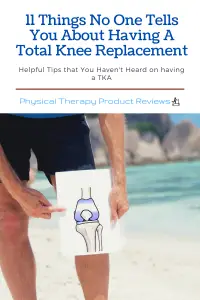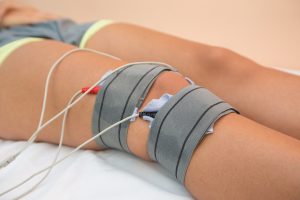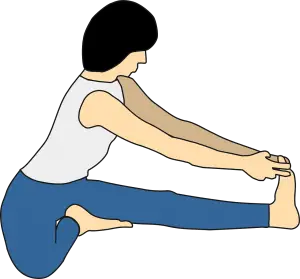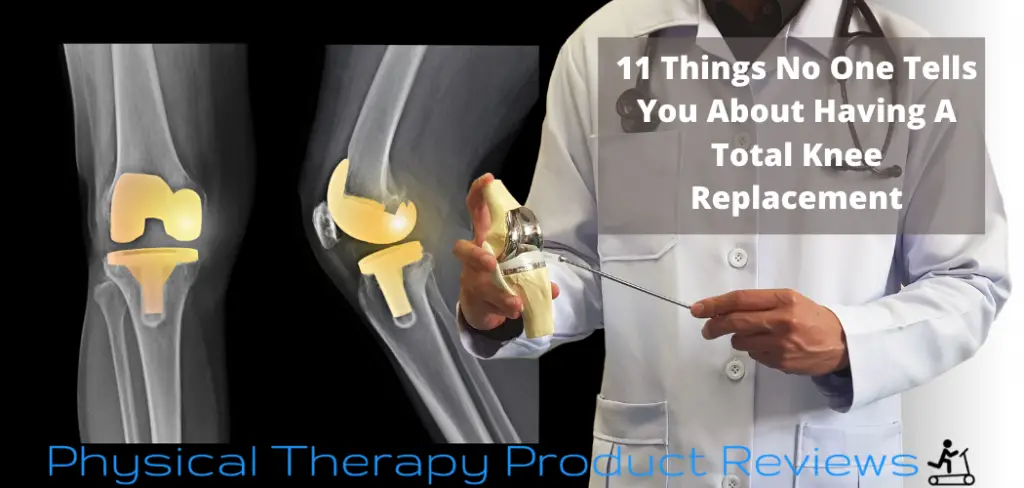 A total knee replacement is the most common orthopedic procedure in the United States. Over half a million(and rising) total knee replacements are done annually.
A total knee replacement is the most common orthopedic procedure in the United States. Over half a million(and rising) total knee replacements are done annually.
Despite the increasing numbers and familiarity with knee replacements, there are many things that no one tells you about recovering from the surgery. Some of them are quite helpful in speeding up recovery.
This article will discuss 11 things that no one tells you about having a total knee replacement. You may be surprised by some of these facts!
The Pain is Real - Knee Replacements Hurt
The pain levels during the first few weeks often catch people off-guard. Compared to other joint replacements, a knee replacement is quite a bit more painful.
Dealing with this pain can be overwhelming. It might even make you scared to move your new joint. However, this will make the pain worse. The best way to combat pain after a knee replacement is to keep it moving.
You also want to listen to your physical therapist for helpful tips to keep it stretched out. Look for other ways to help with pain such as elevation, compression, and short walks.
Physical Therapy and Rehab Can Be Tough
 Physical therapy and rehab will be difficult at times. The first two to three weeks after surgery are often the toughest. They are also critical in regaining the full range of motion. The longer it takes to regain, the harder it will be.
Physical therapy and rehab will be difficult at times. The first two to three weeks after surgery are often the toughest. They are also critical in regaining the full range of motion. The longer it takes to regain, the harder it will be.
The physical therapist will work with you to strengthen the muscles around your total knee replacement joints. They’ll show you exercises designed for strengthening specific parts of the leg or muscle groups. These exercises may be hard on some days, but they’re important in order to improve your quality of life.
Physical therapy doesn’t stop at the office. You need to do these exercises outside of your normal scheduled therapy times, too. It will probably be difficult to motivate yourself to do them at night when the knee is sore, but it’s critical for the overall progress.
Physical Therapy and Rehab Take Time
Rehab after total knee replacement is not a quick process. It takes up to two months for some people to get back on their feet without any limitations at work or home. The focus of rehab will be working through your pain threshold to get you moving again with confidence.
There are going to be days that you don’t want to do your exercises, but each day matters in the overall process.
It’s not unusual to hit a wall of frustration during your recovery. Give yourself some grace. You will get there!
As a reminder, it can take a full year for a total knee replacement to feel “normal.”
"No Pain No Gain" Isn't Necessarily True
I’m sure that you have heard the saying before, but for a total knee replacement, this just isn’t true. Listen to your body. Pain is the body’s way of telling you something is wrong.

Pain levels in the 2-5/10 are great for pushing progress, but anything more than that can slow down recovery. A spike in pain is your body’s way of telling you to ease up a little.
If you push it too far too fast you can cause more stiffness, swelling, and muscle guarding. This will ultimately slow your recovery.
Doing Pre-Hab Exercises Before Surgery Helps
Research shows that doing specific exercises before surgery helps speed up recovery. The more that you can do before surgery to improve range of motion, strength, and endurance, the faster you’ll achieve your recovery goals.
 Some of the most important things to do before surgery are increasing both knee flexion and extension to try and get a normal walking pattern.
Some of the most important things to do before surgery are increasing both knee flexion and extension to try and get a normal walking pattern.
Try and improve strength through bodyweight squats or using a stair to step up and down for multiple repetitions.
If you’re unable to do these, then try going to the local swimming pool. Swimming and water squats are low-impact ways to improve your walking mechanics and strength.
Six Exercises to Do Before a Total Knee Replacement
The Pain Medication is Good and Bad
The first few weeks can be tough on your body with all of the changes in weight distribution, muscle activity, and swelling. Your doctor will most likely prescribe pain medication to help you through this.
The downside to these medications though is that they may make you drowsy or dizzy, which will affect your ability to get around and do things on your own.
Pain meds are also addictive, so it’s important to be aware of the time limit that these medications should last for before taking more. Your doctor will have a better idea, as they know what kind of pain you’re dealing with. Generally, three days is enough.
Just remember- total knee replacements are worth it
Yes, total knee replacements are serious surgery. It can be painful, difficult, and hard to recover from, but after all of that is said and done- You’ll have your life back.
Full Recovery Takes Longer Than You Think
It’s important to remember that total knee replacements are a great surgery, but it doesn’t mean full recovery will be quick. You’ll have good days and bad days. Some weeks you’ll feel like you’re doing more than others. Just know that this is normal.
You’ll be in pain and you’ll need help around the house or work for a few weeks. Just remember, this is temporary. Your total knee replacement will help you get back to the independent lifestyle you love.
You’ll be mostly back to normal by 3 months after surgery, but it often takes a full year before you are fully back to normal.
You'll Walk Different After Surgery
It’s normal to feel a little off-balance after total knee replacement surgery. You might have difficulty with stairs, sitting, or standing for extended periods.
Even a few weeks to months after surgery, walking might not feel right or the same as before surgery. It’s not a big deal, but it can be a little annoying.
The biggest issue is a change in range of motion and stiffness after surgery. This might be noticeable during the normal walking and leg swing during gait.
 Another issue that some people notice is the knee may “click” when the leg swings forward during walking. This click is normal and is simply the prosthesis, but some people find it so annoying that they will modify their walking to prevent it from happening.
Another issue that some people notice is the knee may “click” when the leg swings forward during walking. This click is normal and is simply the prosthesis, but some people find it so annoying that they will modify their walking to prevent it from happening.
Stiffness Is Common and Can Last a Long Time
Some total knee replacement patients experience stiffness in the joints or muscles after surgery. This is most likely due to swelling and pain, but it can also be from a lack of mobility before surgery. The tendons and ligaments weren’t stretched out enough before surgery and will feel stiff after surgery.
Stiffness should gradually go away as you start becoming more active. Some people have chronic issues with this that lasts weeks, or even months, after.
The stiffness is especially prominent after sitting in a chair with your knee bent for a long period or driving for a long distance. This is normal and will eventually go away, but it can take a full year or even two before it’s 100% back to normal.
You'll Likely Need Some Extra Help With Your Activities of Daily Living
For the first few weeks after total knee replacement surgery, it’s important to be aware of what you’re able to do on your own and what you might need help with.
Trust us, everyone needs a little help after surgery, even the big tough guys. It’s perfectly normal to ask for help.
You might need help with groceries, making dinner for one person instead of a family- just know that there are people out there who want to lend an extra hand.
Ask a family member or friend to stay for a week to help out with simple household chores.
You might also need help driving to and from the doctor and physical therapy appointments for a few weeks. We recommend scheduling those out amongst friends far in advance.
Total Knee Replacements Last a Long Time if you Take Care of Them
The total knee replacement is a lifesaver for many people. However, we want to point out that they’re not perfect and do have their risks just like any surgery does- but it’s worth it.
One of the most important things you can do after total knee replacement surgery is talk with your surgeon about what types of exercises are safe at what time. Running isn’t recommended for everyone, downhill skiing is ok for most people, but repeated jumping is usually not good.
Most total knee replacements last between 20-25 years, as long as you don’t have a severe trauma or do repetitive activities that your surgeon recommends against.
Conclusion
Do what you can before surgery to prepare yourself. Speak with your surgeon, complete some pre-hab exercises, and line up help from friends and family. Continue to follow your surgeon and physical therapist’s guidelines afterward and your recovery should go smoothly. You’ll be enjoying your new joint in no time.
Other Great Rehab Related Articles
How to Stay Active After Cervical Fractures: Expert Tips and Advice
Dealing with Painful Stairs After Ankle Replacement Surgery
Walking After a Total Ankle Replacement: Tips for a Successful Recovery
Exercises While Non-Weight Bearing After Ankle Replacement: Elevation, AROM, Leg Raises, and More
Ankle Pain with Stairs: Causes and Home Treatment Options
5 Common Mistakes You’re Making After an Ankle Sprain
Disclaimer: The information provided in this post is for educational purposes only. This is not a substitute for a medical appointment. Please refer to your physician before starting any exercise program.






